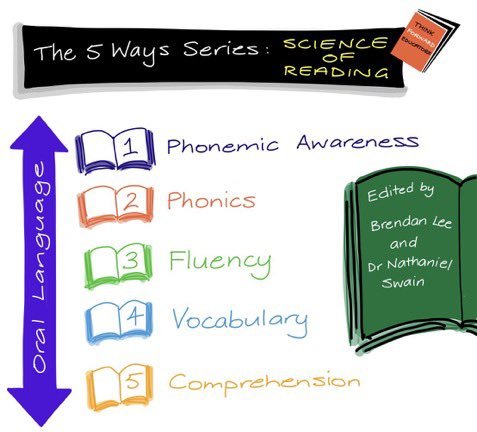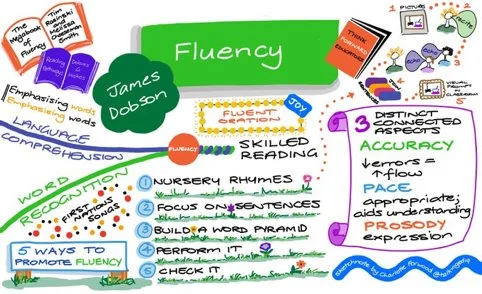5 Ways to: Focus on Fluency
Over the coming weeks, Think Forward Educators will be posting a series of blog articles written by educational experts providing ready-to-use tips on how to implement the Science of Reading into the classroom.
Inspired by Tom Sherrington’s Five Ways Collection, the posts have been edited and curated by Brendan Lee and Dr Nathaniel Swain.
The fourth blog post of the series from structured literacy specialist, James Dobson gives us a fantastic look at fluency.
Listening to actors perform their lines expertly is one of life's great pleasures. It's why the words 'Hamilton', 'Harry Potter', 'SIX', 'Hairspray', and 'Moulin Rouge' are lit up around Melbourne: a fluent orator provides a breath of warm air in the depths of a wet and drizzly winter.
The same is true in the classroom: a child fluently reading a book is a great joy. However, reading may become a chore when a student's reading is stilted and slow. Tripping over words or monotonous reading doesn't help the child's comprehension, and they are probably not developing a passion for reading.
Fluency is one of the 'big six' elements of reading. It is the bridge the reader must tread to take the words written on a page and make meaning from them. Scarborough's Reading Rope conveys this nicely as fluency occurs at the point that the separate strands of word recognition and language comprehension come together as skilled reading.
Fluency comprises three distinct but connected aspects:
1. Accuracy
To be a fluent reader, you need to be able to read the words correctly. Fluency is hindered every time an error is made. Either the reader goes back and corrects, or they may blindly wander on with the meaning eluding them further for every mistake they make. Errors need to be infrequent so that our reading can flow.
2. Pace
Reading words correctly isn't enough to be a fluent reader. You also need to read the words at a reasonable rate. While fast reading is not all there is to fluency, reading words at an appropriate speed aids in our understanding of what we read.
3. Prosody
Being fast and accurate is a good start but it is not all there was to fluent reading. Have you tried listening to audiobooks at double the normal speed? We enjoy it when reading sounds natural and expressive. It is our prosody that makes listening to someone read a great joy.
Putting it into Practice
We must teach our students all three distinct but dependent aspects of fluency. Then our students can become fluent readers who read accurately, with good pace and expressively. I have selected five ways you can focus on fluency with your students.
Start with nursery rhymes
Focus on sentences
Build a pyramid
Perform it
Check it
(1) Start with nursery rhymes
I start the year with my foundation students by teaching nursery rhymes. Some children are familiar with some of them, but many are new to my students. I find that this is a wonderful way to build a sense of community while children develop the confidence to orate in front of their peers. Nursery rhymes are a brilliant opportunity to focus on our prosody.
I show a picture for each nursery rhyme. I also display the words but don't expect my students to read them (because I haven't taught them how to read yet). However, some children start school knowing how to read and showing the words helps them.
I recite the nursery rhyme.
Then I say a line and my students echo it back to me. I'm making sure that the words are correct and the phrasing is similar to mine.
We put the whole nursery rhyme together.
I put a picture of the rhyme up around the room to provide a visual prompt for us to revisit it over the year.
As I teach nursery rhymes, I like to include First Nations songs. Learning nursery rhymes in your students' home languages is another way to build a culture of inclusion while helping students work on their expression. There is a world of poetry to explore with older students, from the enduring legacy of Shakespeare’s sonnets to the contemporary popularity of hiphop.
Once we are comfortable and confident with our nursery rhymes, we perform some. This helps students become comfortable presenting to others and allows them to feel successful.
(2) Focus on sentences
Sometimes we forget how daunting the task of reading aloud can be. Picking up a heavy tome to read can add to that intimidation. For our young students a page full of words can be just as scary. Stripping our fluency instruction down to a single sentence eases this burden.
One technique for focusing on sentences comes from The Megabook of Fluency by Tim Rasinski & Melissa Cheesman Smith. Rasinski is the guru of fluency and this book is packed with practical ways to build students' fluency skills. One such activity is called 'emphasising words'.
You start with a sentence such as:
Ted did not like his pizza with anchovies.
You can highlight different words in the sentence. Students practise reading them aloud by emphasising the highlighted words.
Ted did not like his pizza with anchovies.
Ted did not like his pizza with anchovies.
Ted did not like his pizza with anchovies.
Ted did not like his pizza with anchovies.
This is a great activity because repeating one sentence means that students easily become accurate and automatic with it. We are then free to focus on our expression and how emphasising different words can create a different meaning. You can adapt this activity to incorporate decodable sentences for younger students. Using a famous line from a speech would be a powerful way to explore the possibilities of expression with older students.
(3) Build a pyramid
A while ago, I saw a tweet of words in a pyramid that looked like a strange memorisation activity where a sentence was built up word-by-word. I thought nothing more of it until the next day when the mail arrived and I realised I had ordered a book of these! Reading Pathways by Dolores G Hiskes promises "simple exercises to improve reading fluency". I have been pleasantly surprised that it delivers exactly this!
My foundation students read each line to their partner, carefully tracking with their finger. These pyramids mean that students get repeated exposures to a word. This allows them to read it more fluently each time.
The examples I show here are both linked to the unit we studied about farms, while providing students with extra practice with digraphs such as 'ng', 'ch' and 'ea'.
Reading pyramids help my students build accuracy and then develop automaticity. These pyramids give students the gentle nudge that they need to turn words into sight words. Once we complete a pyramid, we take turns reading the final sentence focusing on natural expression. Word pyramids would be an excellent addition to any early years classroom or intervention program.
(4) Perform it
To build fluency we need to allow our students to repeat what they read. However, it can quickly become a stale task to just reread a text. As educators, we need to consider how we provide a purpose for ensuring our students have the chance to practice reading. Providing an opportunity to perform gives students a reason to rehearse their reading.
I recently witnessed a teacher use a Readers' Theatre script to build their students' fluency to maximum effect.
On the first day, the teacher read the script to their students. They modelled how to deliver it with expression, while the students followed along with their own copy.
The next day, the class were divided into parts. Each part would read their lines in unison. This exercise gave students the chance to focus on their accuracy. The teacher had given thought to which students were assigned each part to ensure that each child would succeed.
For the third and fourth days, the class rehearsed in their small groups. By this stage every part had practiced their lines. This meant that they focused on how to make their lines come alive. Students provided each other with feedback and collaborated to create an expressive performance.
On the fifth day, the various groups went to different classes and performed the short play. It was fantastic to see some students who often lack confidence reading aloud performing with aplomb.
The teacher was successful in supporting their students to improve the prosody because they first ensured that their students' were accurate and automatic with what they read.
(5) Check it
How do we know if our students' fluency is improving? How do we know if there is an issue? We check it. As with any assessment, we need to be mindful of what we are measuring and how this informs our teaching.
One measure is Oral Reading Fluency (ORF). Students read a passage of connected text within a set time. They are assessed on the number of words they read correctly per minute. This means that we have a measure of a student's reading rate and their accuracy. These are both essential elements to measure, and if you use a standardised ORF then you can monitor students who may be at risk.
Technology can also enable us to record students reading fluency. One promising development is the Reading Progress function in Microsoft Teams. A teacher can set up an assignment, including uploading a text, or using one from the sample library (sourced from ReadWorks.org) for students to read. Students record themselves. Their accuracy rate and number of correct words per minute are automatically calculated. This tool has the potential to save teacher time in assessing accuracy and pace. It also allows us to save samples of our students' fluency which is could be valuable when we are reporting on student progress.
While prosody can be a more complicated aspect to assess, educators can easily tell which students are not reading fluently yet. One thing to consider when checking prosody is that a student's automaticity with words is not the barrier. This would then give us a false data set where we think we've assessed their expression, but we've actually been assessing their decoding skills. Therefore it is important for us to make sure we allow our students to practice a text before assessing their prosody.
Using a rubric is one way that we can evaluate prosody. There are plenty available online, including one by Rasinski here. The teacher can complete rubrics, or you can teach your students how to use them to guide peer feedback. It is always crucial to unpack the criteria and provide examples so that students know what you are looking (or listening) for.
Fluency is the bridge between being able to decode to understanding what they read. It is essential that we recognise its importance and teach our students how they can become confident and capable readers.
References:
Hiskes, D. (2007). Reading Pathways: Simple Exercises to Improve Reading Fluency (5th ed). Jossey-Bass Teacher
Rasinski, T., & Cheeseman Smith, M. (2018). The Megabook of Fluency: Strategies and Texts to Engage All Readers. Scholastic
Infographic by Dr. Charlotte Forwood, teacher, speech pathologist and occasional sketchnoter.
About Me:
James Dobson [@jdtdobson on Twitter] is a Foundation teacher and Literacy Learning Specialist in regional Victoria. James has worked with students from a diverse range of backgrounds in Victoria and the Northern Territory. This has made him passionate about ensuring that literacy instruction is rigorous and robust. James has also been a mentor in Think Forward Educators Mentoring Program.
He has recently been nominated for the Outstanding Primary Teacher award as a part of the 2022 Victorian Education Excellence Awards.
James blogs about education at https:// layingthefoundations.weebly.com/






